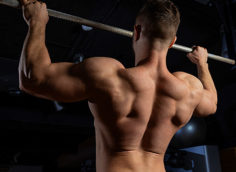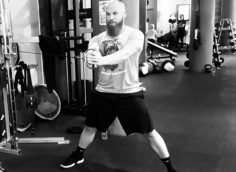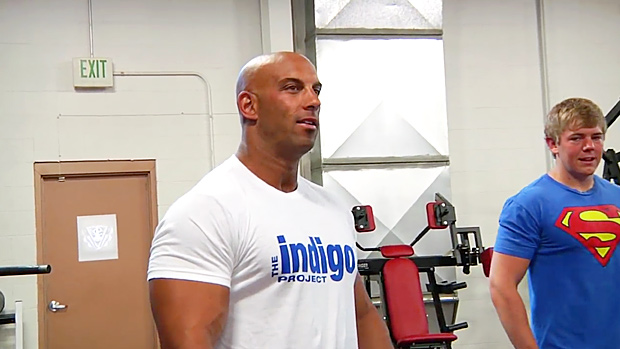The King of Exercises?
If most people were asked what exercise they'd choose if they could only do one, many would say "squat." And while the squat is a great strength exercise, if you want a full and well-developed set of legs, you're going to miss vital parts if the squat is all you do.
The muscles that'll lag behind are the rectus femoris, the big muscle belly that ties the vastus lateralis and the vastus medialis together, as well as your hammies.

The reason the rectus femoris won't develop from squats is because it's a two-jointed muscle. It crosses both the hip joint and the knee joint and works as a flexor of the hip as well as an extensor of the knee.
So when you squat down, the rectus femoris gets longer at the knee end, and shortens at the hip end. This means that it pretty much maintains its length and doesn't contract a whole lot.
EMG-studies have shown that while the vastus muscles contract at a factor 100 during the squat, the rectus only contracts at a factor 50. Confused? Don't worry. Just know that a low level of contraction equals less hypertrophy (growth).
Research backs this up. One such study from Fonseca et al. had a bunch of participants do a whole range of quad exercises (squats, lunges, leg presses and deadlifts), and a different bunch do squats. While the multi-exercise participants achieved growth in all four parts of the quads, the squat-participants consistently lacked growth in the rectus femoris.
In another study, 8 weeks of squatting resulted in significant growth of the vasti (plural for both vastus) muscles, but no growth was seen in the rectus femoris.
Researchers studied rowers and road racing cyclists and found little growth of their rectus femoris as well. Think about that. Rowing and bike riding require the same biomechanics as the squat – simultaneous knee and hip flexion, which evidently results in sparse rectus activity.
The single-joint movements, like the leg extension.

In one study (Ema et al), researchers put this theory to the test, and found that leg extensions resulted in more growth of the rectus femoris (26%) than the vastus medialis (12%), the vastus intermedius (6%) and the vastus lateralis (11%) after 12 weeks of training.
In addition, a couple of older studies showed that the squat was more efficient than leg extensions in terms of activation of the vastus lateralis and vastus medialis, but as for the rectus femoris, leg extensions were definitely superior.
A lot of lifters think that the squat works the entire thigh, including the hamstring muscles. This makes sense in the way that the hamstrings – besides being flexors of the knee – are also extensors of the hip. And as you go up in the squat, you extend the hip.
The hammies do get some work during squats; they co-contract alongside the quads. However three out of the four muscles that make up this muscle group are two-joint muscles. This includes the semitendinosus, the semimembranosus and the long head of the biceps femoris.

Only the short head of the biceps femoris is a one-joint muscle, and so three-fourths of the hams end up in the same debacle as the quads, being elongated at one end and shortened at the other during squats, and pretty much maintain their length.
Some studies show that activation of the hammies during squats was about 50% of the activation observed during leg curls and stiff-legged deadlift, two exercises in which one joint is fixed and one joint is moving.
One study by Ebben found that the most effective hamstring exercise is the Nordic ham curl (activation factor 98).
Nordic Ham Curl
This was followed by the seated leg curl (factor 81), then stiff-legged deadlift (factor 49), the good morning (factor 43), and then the squat (factor 27).
One could argue that adding more weight to the squat puts greater stress on all muscles including the hammies, and so this may be a way of inflicting more damage to the hams. Studies show however that adding weight only increases stress on the glutes and vasti, whereas the activity of the hams remain unchanged.
We see a similar pattern during lunges, where Riemann et al. showed that the heavier you go in lunges, the more stress is placed on the glutes and hamstrings, whereas the stress on the quads remains pretty stable, even with increasing weight. Lunges are also very efficient builders of the adductors, the last piece missing in the leg building puzzle.
So if you add up all the research on muscle activation, you can put together the ultimate exercise combination for developing a complete set of wheels:
- Squats for vasti and glute development
- Leg extensions for rectus femoris
- Leg curls, Nordic hamstring curls, or stiff-legged deadlift for hammies
- Variations of lunges for adductors and glutes, e.g. Bulgarian split squats
So re-evaluating the "king of exercises" rhetoric, we may have to conclude that in reality it seems to be more of a Seven Kingdoms, Game of Thrones-like situation with several different kings, rather than a Lord of the Rings one-exercise-to-rule-them-all situation.
- Ema R et al. Unique activation of the quadriceps femoris during single- and multi-joint exercises.Eur J Appl Physiol. 2016 May;116(5):1031-41.
- Escamilla RF et al. Biomechanics of the knee during closed kinetic chain and open kinetic chain exercises. Med Sci Sports Exerc. 1998 Apr;30(4):556-69.
- Ema R et al. Unique muscularity in cyclists' thigh and trunk: A cross-sectional and longitudinal study. Scand J Med Sci Sports. 2016 Jul;26(7):782-93.
- Ema R et al. Inferior muscularity of the rectus femoris to vasti in varsity oarsmen. Int J Sports Med. 2014 Apr;35(4):293-7.
- Earp JE et al. Inhomogeneous Quadriceps Femoris Hypertrophy in Response to Strength and Power Training. Med Sci Sports Exerc. 2015 Nov;47(11):2389-97.
- Wakahara T et al. Inter- and intramuscular differences in training-induced hypertrophy of the quadriceps femoris: association with muscle activation during the first training session. Clin Physiol Funct Imaging. 2017 Jul;37(4):405-412.
- Ema R et al. Inhomogeneous architectural changes of the quadriceps femoris induced by resistance training. Eur J Appl Physiol. 2013 Nov;113(11):2691-703.
- Fonseca RM et al. Changes in exercises are more effective than in loading schemes to improve muscle strength. J Strength Cond Res. 2014 Nov;28(11):3085-92.
- Stuart MJ et al. Comparison of intersegmental tibiofemoral joint forces and muscle activity during various closed kinetic chain exercises. Am J Sports Med. Nov-Dec 1996;24(6):792-9.
- Ebben WP. Hamstring activation during lower body resistance training exercises. Int J Sports Physiol Perform. 2009 Mar;4(1):84-96.
- Schoenfeld BJ et al. Regional Differences in Muscle Activation During Hamstrings Exercise. J Strength Cond Res. 2015 Jan;29(1):159-64.
- Kubota J et al. Non-uniform changes in magnetic resonance measurements of the semitendinosus muscle following intensive eccentric exercise. Eur J Appl Physiol. 2007 Dec;101(6):713-20.
- Ono T et al. Hamstring functions during hip-extension exercise assessed with electromyography and magnetic resonance imaging. Res Sports Med. 2011 Jan;19(1):42-52.
- Bourne MN et al. Muscle activation patterns in the Nordic hamstring exercise: Impact of prior strain injury. Scand J Med Sci Sports. 2016 Jun;26(6):666-74.
- Zebis MK et al. Kettlebell swing targets semitendinosus and supine leg curl targets biceps femoris: an EMG study with rehabilitation implications. Br J Sports Med. 2013 Dec;47(18):1192-8.
- Mendiguchia J et al. Nonuniform changes in MRI measurements of the thigh muscles after two hamstring strengthening exercises. J Strength Cond Res. 2013 Mar;27(3):574-81.
- Signorile JF et al. Range of motion and leg rotation affect EMG activation levels of the superficial quadriceps muscles during leg extension. J Strength Cond Res. 2014 Sep;28(9):2536-45.





